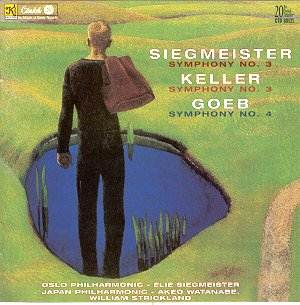AMERICAN SYMPHONIES
ROGER GOEB (1914-97) Symphony No. 4
(1954)
HOMER KELLER (1915-?) Symphony No. 3
(1955?)
ELIE SIEGMEISTER (1909-1991) Symphony No. 3
(1957)
 Japan Philharmonic SO/Akeo
Watanabe (Goeb) rec 1961
Japan Philharmonic SO/Akeo
Watanabe (Goeb) rec 1961
Japan Philharmonic SO/William Strickland (Keller) rec 1959
Oslo Philharmonic SO/composer (Siegmeister) rec June 1964
 CITADEL CTD88121
[60.54]
CITADEL CTD88121
[60.54]
Crotchet
Amazon
US

These recordings are all CRI stereo originals on licence. They are between
35 and 40 years old but apart from a slight hardness sound very respectable
and representative technically, underpinned by an unwavering level of silky
analogue hiss.
The Goeb is in three movements each lacking a tempo marking title. Goeb studied
with Boulanger and Luening and most assuredly was influenced by Stravinsky.
The first movement cuts and crosses punched out rhythms with an unsmiling
but undeniably exciting edge. Goeb must surely have enjoyed the Rite of Spring.
Over the dissonance of the string music a bluntly heroic brassy theme evolves
bursting with all the confidence of de Falla's Miller. The last movement
is not short of nervy dynamism, angular gestures from the brass or spry
intellectualism.
Goeb's Third Symphony conducted by Stokowski is on Citadel CTD 88123.
Homer Keller was a graduate of Eastman where he studied with Hanson and with
Bernard Rogers (the latter a composer whose music deserves reappraisal).
He studied in Paris with Honegger. His first symphony was taken up by Barbirolli
in New York in 1940 and his Second was given by the National SO in Washington
in 1950.
Keller's work is in five movements. His style avoids atonality while still
sounding of its time and place. There is a certain open air quality, a jazziness,
a sense of plaintive prairie song, a raw power and a solitary's pioneer
confidence that runs through the US symphonies of this era. Its brass roll,
its percussion stomp; it is a work of spark and delight - not too dissimilar
from Piston's symphonies 4 and 6.
Siegmeister studied with Seth Bingham at Columbia and with Riegger and Boulanger.
He was choral director for Broadway musicals and organised the American Ballad
Singers to revive American folksong. It was this last genre that infused
his Sing Out Sweet Land, Ozark Set (1943) and Western Suite (1945). His Third
Symphony was premiered by the Oklahoma City SO under the redoubtable Guy
Fraser Harrison in 1959. The Siegmeister symphony is a tougher briar bush
than the Keller or Goeb. It is dissonant at first but shakes this off for
the andante emerging into a string anthem of aspirant set and serene character.
The final Ritmico has ideas rushing, scavenging and scattering all over the
place: syncopated, vital and bright. This jazziness was to be picked up and
amplified in the contemporaneous Clarinet Concerto - also premiered in Oklahoma
City.
The liner booklet and back cover complement rather than duplicate each other.
The notes are by the composer in each case. Some biographical material is
provided.
Splendid performances of intriguing and rarely encountered works. If they
lack the lyrical belt of a Schuman or Hanson they represent several aspects
of the texture of American music in the 1950s.
Rob Barnett

Am I the only one to hope that Citadel will now turn their attention to the
symphonies of Cecil Effinger? I think I can hear the answer!
can be ordered via www.earthlink.net/~citadel

